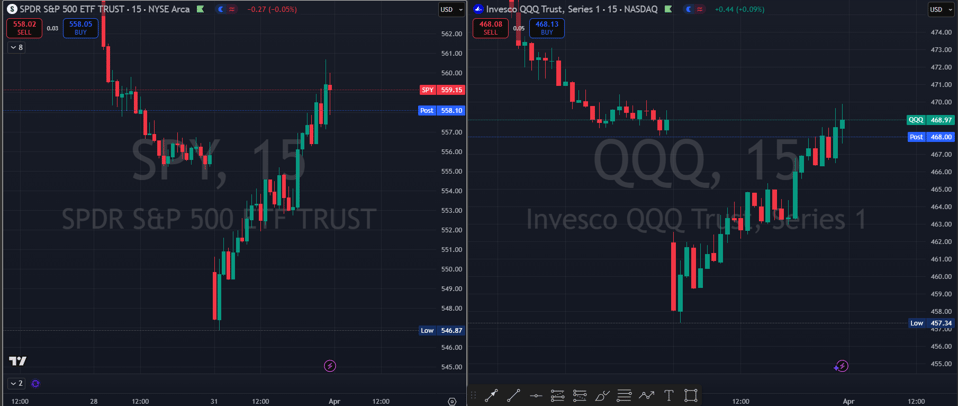Market Review 31st March 2025
Simplify the craziness
DAILY REVIEW
N
3 min read
Market Overview: Stocks Reverse Losses to End Higher
North American stock markets rebounded sharply on Monday, capping off a volatile trading session to close the month and quarter. After a weak open, major indices recovered as investors digested fresh trade policy headlines and the upcoming April 2 U.S. tariff announcement.
Key Takeaways:
The Dow Jones Industrial Average (DJIA) surged 1% (approximately 400 points), reversing early losses.
The S&P 500 rebounded from a 1.7% drop to close up 0.6%.
The Nasdaq Composite slipped 0.1%, weighed down by tech sector weakness.
Bond yields declined, with the 10-year U.S. Treasury yield falling to 4.22% and the 10-year Government of Canada bond yield at 2.97%.
Value stocks (consumer staples, utilities) outperformed, while growth stocks (technology) lagged.
Despite the positive session, markets wrapped up March on a weak note, posting their worst quarter since 2022. Investors continue to grapple with economic uncertainty, largely driven by trade policies and inflation concerns.
April 2: The Market’s Next Big Test
- U.S. Tariff Announcement
The primary focus for markets this week is the much-anticipated April 2 tariff announcement, which could introduce a more aggressive U.S. trade policy. Since mid-February, tariff uncertainty has weighed on equities, with the S&P 500 down roughly 9% from its all-time high.
Why It Matters:
The U.S. plans to implement reciprocal tariffs to match duties imposed by other countries.
Reports suggest a more aggressive stance than initially expected, increasing market uncertainty.
The new tariffs could raise costs, slow economic growth, and dampen corporate investment.
Major U.S. trading partners are expected to retaliate, which could further impact global markets.
Investor Outlook:
Diversification remains key: Despite U.S. equity struggles, international developed large-cap stocks are up 9% YTD, and emerging markets are up 4.5%.
Bond markets offer some relief, with investment-grade bonds gaining over 2.5% YTD.
Volatility will persist, but maintaining a balanced portfolio can help investors navigate uncertain periods.
Labour Market Data in Focus This Week
While trade policy dominates headlines, investors are also watching the labor market for economic clues. This week brings several key employment reports:
Upcoming Data Releases:
Tuesday: U.S. JOLTS job openings (February) – Expected to drop slightly to 7.7 million.
Friday: U.S. Nonfarm Payrolls (March) – Forecasted 123,000 job additions; unemployment expected to tick up to 4.2%.
Friday: Canada Labour Force Survey – Expected 23,000 job additions, with unemployment rising to 6.7%.
Why This Matters:
The labor market has remained strong, with job openings exceeding unemployment levels.
Any weakness in hiring could signal slowing economic momentum, adding pressure on equities.
A hotter-than-expected jobs report could renew inflation concerns, influencing Federal Reserve policy.
Markets End a Rough Quarter: Worst Since 2022
Despite Monday’s gains, U.S. stocks recorded a disappointing first quarter.
Quarterly Performance:
S&P 500: Down 4.5% YTD
Nasdaq Composite: Down over 10% YTD
Dow Jones: Mixed performance, buoyed by value stocks
Biggest Laggards:
Nvidia (NVDA): Down nearly 20% YTD
Tesla (TSLA): Down over 35% YTD
Other megacaps have also struggled, dragging down tech-heavy indices.
Why the Sell-Off?
Trade war uncertainty: Investors fear escalating U.S. tariffs and potential retaliation.
Inflation concerns: The recent hotter-than-expected PCE inflation report has rattled markets.
Shifting Fed expectations: Markets are unsure how the Federal Reserve will respond to economic developments.
Investor Sentiment: Cautious but Hopeful
Markets remain in a delicate position, balancing economic fundamentals, trade policy risks, and inflation concerns. While Monday’s rally is encouraging, volatility is likely to persist.
Key Market Themes Moving Forward:
April 2 Tariff Announcement: The biggest near-term risk.
Labor Market Trends: Will hiring slow down?
Federal Reserve Policy: How will inflation data impact rate decisions?
Earnings Season (April): Corporate outlooks will be crucial for market direction.
Investment Strategies:
Diversification remains critical: A mix of U.S., international, and bond holdings can help weather volatility.
Stay defensive: Consumer staples, healthcare, and utilities are outperforming.
Monitor tech stocks: Once market leaders, they have struggled recently, making valuations more attractive.
Final Thoughts
Monday’s market rally was a welcome relief after a rough month and quarter, but uncertainty remains. With the April 2 tariff decision looming and key employment data ahead, investors should prepare for continued volatility in the coming weeks.
The best approach? Stay diversified, focus on fundamentals, and be ready for market swings.
References
Nasdaq Composite Index - MarketWatch
Dow Jones Industrial Average - CNBC
Federal Reserve Interest Rate Outlook - Federal Reserve
JOLTS Job Openings - U.S. Bureau of Labor Statistics
Nonfarm Payrolls Data - U.S. Bureau of Labor Statistics
Government of Canada Bond Yields - Bank of Canada
$AAPL $MSFT $NVDA $AMZN $GOOGL $META $BRK.A $BRK.B $TSLA $AVGO $LLY $TSM $WMT $JPM $V $TCEHY $XOM $MA $UNH $COST $JNJ $PG $NFLX $ORCL $ABBV $HD $BABA $BAC $KO $SAP $TMUS $CVX


